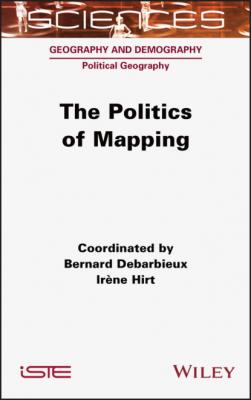ТОП просматриваемых книг сайта:
The Politics of Mapping. Bernard Debarbieux
Читать онлайн.Название The Politics of Mapping
Год выпуска 0
isbn 9781119986744
Автор произведения Bernard Debarbieux
Жанр География
Издательство John Wiley & Sons Limited
Table of Contents
1 Cover
4 Introduction I.1. Theoretical and conceptual debates I.2. Political practices and uses of maps I.3. The structure of this book I.4. References
5 1 The Map as a Legitimate Space: Cartography as a Language, a Stage and an Issue 1.1. Introduction 1.2. Map truth regimes 1.3. The new spaces of the electoral map 1.4. Cartographic turn, geographic turn and political space 1.5. Ethical turn and mapping 1.6. Mapping, citizen science 1.7. References
6 2 Cartography and Spatial Production of Society 2.1. The map, politics and morality 2.2. The map, territory and globe 2.3. The map, order and modernity 2.4. The map, reason and rhetoric… 2.5. The map, constraint and the self-organization… 2.6. The map, production and society 2.7. References
7 3 Farewell to Maps: Reformulating Critical Cartography in the Digital Age 3.1. Introduction 3.2. Farewell to maps: when the digital world disrupts the objects and questions of a research current 3.3. The shortcomings of critical mapping exacerbated by digital technology 3.4. Reformulating critical mapping in the digital age 3.5. Conclusion 3.6. References
8 4 Mapping and Participation in the Topos and Chora Test 4.1. Introduction 4.2. Participatory mapping tested by topos and chora 4.3. Toward a reflective approach to participatory mapping 4.4. From solicited mapping to collaborative systems and digital traces 4.5. The new boundaries of collaborative mapping systems produced by geolocation technologies 4.6. Representing the spatiotemporal dimension of urban mobility using data produced by inhabitants 4.7. Toward a reflective and chorographic approach to collaborative mapping systems 4.8. Conclusion 4.9. References
9 5 The Cartographic Factory of Modern States 5.1. Introduction 5.2. The invention of spatial modernity in the Renaissance 5.3. State imaginaries of space and territory 5.4. The construction of the nation-state through the map 5.5. The colonial adventure: a counter-illustration? 5.6. Maps and the government of things and people 5.7. Current state of the issue 5.8. References
10 6 Statistical Cartography and International Governance in the Age of Big Data 6.1. Introduction 6.2. Birth and internationalization of statistical cartography 6.3. International statistical mapping 6.4. Cartography in the digital age 6.5. Mapping the SDGs 6.6. (Re)configurations of international cartography 6.7. Conclusion 6.8. References
11
7 Indigenous Mapping: Reclaiming Territories, Decolonizing Knowledge
7.1. Introduction
7.2. Conceptual and theoretical milestones
7.3. Using maps to claim rights and reclaim territories
7.4. Decolonizing maps and cartography
7.5. Conclusion
7.6.

